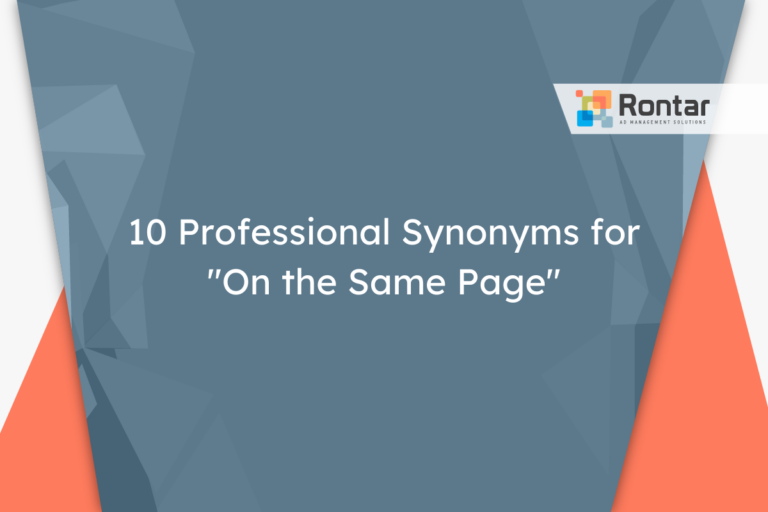10 Other Ways to Say “In My Opinion”

Communicating effectively in a professional setting often involves sharing your thoughts and opinions. However, repeating the phrase “in my opinion” can become redundant and may not always fit the tone you’re aiming for.
This article lists ten alternative phrases that can be used in workplace emails to express your viewpoints in a more varied and engaging way. Each alternative is explained in detail, along with specific examples of how to use them in your messages.
Is It Formal to Say “In My Opinion”?
The phrase “in my opinion” can be seen as both professional and polite, but it’s often considered more informal than other options available. In professional settings, especially in written communications like reports or presentations, we recommend considering more formal alternatives. However, “in my opinion” is a great choice for situations where you need to express a personal viewpoint while maintaining courtesy.
This phrase works well in emails, meetings, or discussions where you want to firmly state your perspective without appearing too authoritative. It’s suitable for conversations with colleagues, in team meetings, or semi-formal email correspondence.
Email example:
Dear Alex,
I've reviewed the project proposal, and in my opinion, we should consider extending the timeline to ensure quality. This will give us enough room to conduct thorough testing and incorporate feedback effectively.
I look forward to hearing your thoughts on this.
Best regards,
Emily
Now, let’s talk about the pros and cons of using “in my opinion.”
Pros:
- It clearly expresses that a statement is your personal viewpoint.
- Helps to soften statements, making them appear less assertive or aggressive.
- Can make the tone of your message seem more approachable.
Cons:
- May be viewed as unnecessary in contexts where your role implies it’s your opinion.
- Can sound less authoritative, which might not be suitable in certain formal or professional settings.
- In written communications, overuse can clutter the message and dilute its impact.
There might be times when someone wants to use an alternative phrase instead of “in my opinion.” This could be due to a desire for a more formal tone or to avoid repetition. Exploring synonyms or alternatives can be a way to tailor your language more closely to your audience or the situation at hand.
10 Other Ways to Say “In My Opinion”
Finding the right words to express your thoughts can make your messages more effective. Here are ten alternatives to “in my opinion” that are perfect for a workplace email:
- I believe
- From my perspective
- To my mind
- As I see it
- It seems to me
- I think
- In my view
- My view is
- I consider
- Personally speaking
1. I believe
Compared to “in my opinion,” “I believe” conveys a similar level of personal conviction but sounds a bit stronger. It’s a great synonym that adds a touch of confidence to your statement without coming off as too aggressive. This alternative is polite yet professional, making it a solid choice for a range of communications, from emails to meetings.
This phrase works well in both written and verbal exchanges, particularly when you want to assert your thoughts without overpowering the conversation. It’s suited for dialogues with peers or presentations to management, where a balanced blend of assertiveness and professionalism is needed.
Example:
Dear Mark,
I believe the proposed budget will not cover all our project needs, especially in the marketing department. Let's discuss this further.
Best,
Elena
2. From my perspective
“From my perspective” shifts the focus slightly, emphasizing that the viewpoint is yours alone, which can make it seem more subjective. As such, it’s a polite and professional way to present your thoughts, particularly when you’re aiming to underscore that you understand others might see things differently. This alternative strikes a nice balance between personal opinion and openness to dialogue.
Great for emails and meetings where diverse viewpoints are being shared, this phrase helps to frame your contributions as just one part of a larger conversation. It’s especially effective in collaborative settings or when communicating with higher-ups who appreciate a humble approach.
Example:
Dear Jamie,
From my perspective, shifting the project's direction at this stage could lead to significant delays. Could we review the implications together?
Sincerely,
Hannah
3. To my mind
“To my mind” is another effective synonym that’s akin to “in my opinion.” It suggests a thoughtful consideration of the topic at hand. While still informal, this choice is polite and somewhat informal, making it a good fit for less formal email correspondences or during team discussions where everyone is sharing insights.
It’s appropriate for internal emails or smaller group discussions. This alternative shines in environments where personal reflection and individual insights are valued, such as in creative brainstorming sessions or strategy meetings.
Example:
Dear Clara,
To my mind, we should explore alternative solutions before making a final decision on this matter.
Warm regards,
Leo
4. As I see it
Compared to the original phrase, “As I see it” is a direct way to share your viewpoint. It’s professional and polite, indicating that what follows is your personal perspective. This alternative is excellent for conversations where you wish to present your stance without dismissing other viewpoints.
This phrase is best used in discussions or correspondence where clarity is paramount but you still want to acknowledge that you’re open to other interpretations. It’s suitable for emails to colleagues or in meetings where clear communication is key.
Example:
Dear Oliver,
As I see it, prioritizing customer feedback in our next phase will significantly enhance product satisfaction.
Kind regards,
Sophie
5. It seems to me
“It seems to me” is a softer, more reflective alternative to “in my opinion.” It subtly conveys that your statement is based on personal observation or thought. This choice is polite and somewhat informal, perfect for when you’re trying not to appear too definitive or when suggesting something that may prompt further discussion.
Ideal for speculative discussions or when floating preliminary ideas to your team or supervisor. It softens your message, making it more about opening up dialogue than dictating a particular direction.
Example:
Dear Carla,
It seems to me that we could increase our efficiency by reorganizing the workflow.
Best,
Tom
6. I think
“I think” is the most direct and straightforward of all the alternatives. It’s professional and polite, yet carries a simplicity that makes it incredibly versatile. This phrase is perfect for almost any situation where you need to express your thoughts clearly and concisely.
This alternative is particularly effective in emails, reports, or during meetings where brevity is appreciated. It can be used with colleagues, superiors, or clients, offering a clear indication of your thought process without excess formality.
Example:
Dear Max,
I think a meeting next week to discuss the project timeline would be beneficial for everyone involved.
Regards,
Lisa
7. In my view
“In my view” is quite similar to “in my opinion” but feels slightly more formal. It is professional and polite, making it an excellent choice for workplace communications where you want to emphasize your personal stance on an issue.
Best suited for formal reports, proposal evaluations, or during decision-making discussions. This phrase is particularly useful when addressing senior management or in any communication where you wish to underline the subjectivity of your assessment.
Example:
Dear Janet,
In my view, reallocating resources to the marketing department will yield higher returns in Q4.
Best wishes,
Greg
8. My view is
The phrase “My view is” is a direct statement of opinion that’s synonymous with expressing personal perspectives. It’s professional, yet slightly more assertive. This alternative is suitable for moments when you’re providing analysis or conclusions in a matter-of-fact manner.
It’s well-suited for writing reports, making recommendations, or any scenario where your role requires you to give an informed opinion. This alternative is particularly effective for correspondence with stakeholders or team leaders who value straightforward communication.
Example:
Dear Nina,
My view is that investing in new technology will greatly enhance our operational efficiency.
Kindly,
Hugh
9. I consider
“I consider” is a thoughtful and considerate way to introduce your opinion. It suggests a level of reflection and analysis, making it professional and polite. This phrase is ideal for contexts where decisions are based on careful consideration of all factors.
This alternative is appropriate for in-depth analyses, strategic planning emails, or reports. It shines in professional settings where your arguments and recommendations need to show a high level of diligence and thoughtful examination.
Example:
Dear Eric,
I consider the proposed changes to be in alignment with our long-term strategic goals.
Yours sincerely,
Diana
10. Personally speaking
“Personally speaking” is a bit more casual than “in my opinion,” but it’s still professional enough for workplace communication. It has a polite air to it that implies the message is from your unique perspective. This phrase is particularly useful when you want to distinctly separate your personal views from your professional role.
This phrase can be especially effective in communications that call for a personal touch, such as feedback to colleagues or in discussions where sharing personal experiences or preferences is relevant. It’s valuable for creating a distinction between the professional and the personal.
Example:
Dear Sam,
Personally speaking, I find the new software to be more user-friendly than our previous system.
Cheers,
Kevin
Final Thoughts
Choosing the right words can change how your message is received in a professional setting. The ten alternatives to “in my opinion” provided in this article are great tools for any workplace communication. They offer a range of tones, from formal to more casual, allowing you to match your language to the situation at hand.






